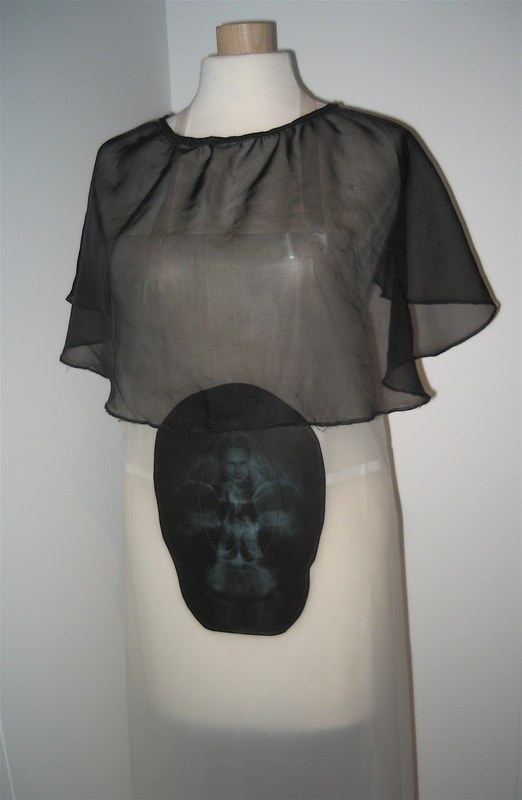Annelies Slabbynck

Straitjacket
White cotton masks sewn into a straitjacket. 2006
$2900
Apron I
Nurse's apron with IV pouches and vintage photographs. 2006
$1400
Apron II
Nurse's apron with vintage collar and skull x-ray. 2006
$1300
Website: www.annelies-slabbynck.be/
Ghent, Belgium
VO by McKerrin Kelly
White cotton masks sewn into a straitjacket. 2006
$2900
Apron I
Nurse's apron with IV pouches and vintage photographs. 2006
$1400
Apron II
Nurse's apron with vintage collar and skull x-ray. 2006
$1300
Website: www.annelies-slabbynck.be/
Ghent, Belgium
VO by McKerrin Kelly
ABOUT THE ARTWORK:
"The straitjacket is made out of white cotton mouth masks, all hand sewed together. It refers to a few pieces out the Prinzhorn collection, which holds art made by female psychiatric patients. A few of the patients created extraordinary pieces/installations containing textile elements, all handmade with almost hidden messages in it. This piece needed a lot of patience because it’s all handmade, which is a nice link to the typical handwork of women in the past.
I was living in China when I made these pieces and enjoyed easy access to all sorts of professional medical tools. You could find a wide array of mouth masks, partly due the pollution. The white masks are very light and these particular sorts are used in the medical world. The masks stand for a healing/protecting/caring aspect. Using the masks to build a straitjacket changes those aspects, giving the piece an overprotective and suffocating feeling.
The aprons refer to a woman’s social position in the past (and today in certain countries and cultures) as a caring/nursing individual to serve and help others. The young girl behind the x-ray of a skull is doomed until her death to dedicate her life towards others.”
I was living in China when I made these pieces and enjoyed easy access to all sorts of professional medical tools. You could find a wide array of mouth masks, partly due the pollution. The white masks are very light and these particular sorts are used in the medical world. The masks stand for a healing/protecting/caring aspect. Using the masks to build a straitjacket changes those aspects, giving the piece an overprotective and suffocating feeling.
The aprons refer to a woman’s social position in the past (and today in certain countries and cultures) as a caring/nursing individual to serve and help others. The young girl behind the x-ray of a skull is doomed until her death to dedicate her life towards others.”
BIO:
Annelies Slabbynck lives and works in Ghent, Belgium. At 17 Annelies started her art education by studying Decorative Arts and Crafts; she now specializes in ceramics. Along with her clay work, antique garments, embroidery techniques, and medical objects/themes take a prominent place in her art.
Her first encounter with China was in 1997, where she stayed for four months at the Central Academy for Art and Design in Beijing. She alternated living and working between Belgium and Shanghai from then until 2015.
Annelies Slabbynck lives and works in Ghent, Belgium. At 17 Annelies started her art education by studying Decorative Arts and Crafts; she now specializes in ceramics. Along with her clay work, antique garments, embroidery techniques, and medical objects/themes take a prominent place in her art.
Her first encounter with China was in 1997, where she stayed for four months at the Central Academy for Art and Design in Beijing. She alternated living and working between Belgium and Shanghai from then until 2015.
DESCRIPTIONS:
Straitjacket:
Three garments are displayed on dress forms.
The first garment is sack like and ankle length with a scooped neck and no apparent arms. The dress is made from white cotton surgical masks that are sewn together.
Apron I:
The second garment is an apron with three pockets made of empty, clear IV bags. Inside each bag is a tin-type like image of a woman. Blue and yellow IV valves dangle below the images. The neck strap is IV tubing.
Apron II:
The last garment is an apron with a straight skirt and a sheer black, elbow length cape. A pear shaped panel of black fabric is hand sewn over the abdomen. On it is a gray x-ray of a skull and an image of a smiling woman who has her hands clasped under her chin.
-descriptions by Teri Grossman
Three garments are displayed on dress forms.
The first garment is sack like and ankle length with a scooped neck and no apparent arms. The dress is made from white cotton surgical masks that are sewn together.
Apron I:
The second garment is an apron with three pockets made of empty, clear IV bags. Inside each bag is a tin-type like image of a woman. Blue and yellow IV valves dangle below the images. The neck strap is IV tubing.
Apron II:
The last garment is an apron with a straight skirt and a sheer black, elbow length cape. A pear shaped panel of black fabric is hand sewn over the abdomen. On it is a gray x-ray of a skull and an image of a smiling woman who has her hands clasped under her chin.
-descriptions by Teri Grossman
DONATE via Fractured Atlas!

Opulent Mobility by A. Laura Brody is licensed under a Creative Commons Attribution-ShareAlike 4.0 International License
The Opulent Mobility license refers to the exhibit and its audio descriptions. Individual artworks are the property of the individual artists.




